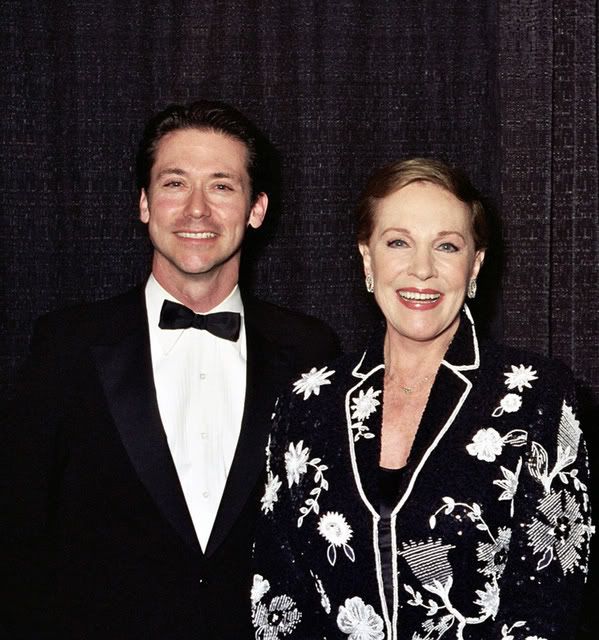My fair Julie: Ms. Andrews recalls `Home’

I share the above photo not because I have a huge ego and want the world to know I had a few quality moments with Dame Julie Andrews, one of my favorite people on the planet. Wait – that's exactly what I wanted by sharing the photo, which was taken at a stem cell research benefit in San Francisco that Andrews spoke at.
The first movie I ever saw was Mary Poppins (actually the very first movie I "saw" as a babe in arms was when my parents, in their VW bug took me to a drive-in showing of Barbarella, and apparently I cried all the way through and they left early). Andrews as the practically perfect nanny made quite an impression on my 4-year-old brain, and from then on, my world revolved around Julie Andrews, who had a TV variety show on then (this was the early '70s), and then my mom and grandma took me to see The Sound of Music. Well, that was it. I've been a Banks-VonTrapp child in her charge ever since.
I reveal these personal details as a form of memoir and to introduce my thoughts on Andrews' memoir Home: A Memoir of My Early Years (Hyperion, $26.95). The book takes us from her childhood in Walton-on-Thames, her career in the dying days of vaudeville as a child performer with a freakishly adult operatic range, and then on to New York and her Broadway stints in The Boyfriend, My Fair Lady and Camelot.

The book ends right as Andrews and her infant daughter are heading for Hollywood, the open arms of Walt Disney and the filming of Mary Poppins.
One thing you notice right away about the book is Andrews' distinctive voice. You can hear her crisp pronunciation in every sentence. It's also clear that she's a writer – no surprise to those of us who have enjoyed her children's books such as The Last of the Really Great Whangdoodles and the more recent The Great American Mousical.
That said, there's still an element of distance between Andrews and the reader. She's happy to tell us a few things – even unpleasant things from her childhood (like a stepfather who had designs on his pretty stepdaughter and the revelation that she was a product of a one-night stand) – but she won't tell us everything. Andrews reveals just enough to protect her privacy, and that's respectable (though not as juicy as some folks might want).
The closest the book comes to scandal is Andrews' revelation that during the run of Camelot, Richard Burton made advances toward her, which she basically laughed off, and then he became cold and distant – even onstage, which seems highly unprofessional, even for a Welshman. Eventually he got over himself and reverted back to the warm and wonderful (if slightly sozzled) co-star Andrews adored.
 One of the book's nicest surprises is the deep friendship Andrews and her husband, Tony Walton (an esteemed Broadway designer), developed with T.H. White, the author of The Once and Future King, the source material for Camelot. Tim, as Andrews called him, comes across as quite a character, especially when he tricks Andrews and Walton into buying a little house on his home island of Alderney.
One of the book's nicest surprises is the deep friendship Andrews and her husband, Tony Walton (an esteemed Broadway designer), developed with T.H. White, the author of The Once and Future King, the source material for Camelot. Tim, as Andrews called him, comes across as quite a character, especially when he tricks Andrews and Walton into buying a little house on his home island of Alderney.
Andrews admits that her account of My Fair Lady's birth isn't as thorough as Alan Jay Lerner's On the Street Where You Live or Moss Hart's Act One (one of the best theater books ever), but it's fascinating to hear about it from her perspective as a young performer who feels she's in way over her head.
My favorite passage in the book about what the theater means to Andrews. Here's a taste:
Once in a while I experience an emotion onstage that is so gut-wrenching, so heart-stopping, that I could weep with gratitude and joy. The feeling catches and magnifies so rapidly that it threatens to engulf me.It starts as a bass note, resonating deep in my system. Literally. It's like the warmest, lowest sound from a contrabass. There is a sudden thrill of connection and an awareness of size – the theater itself, more the height of the great stage housing behind and above me, where history has been absorbed, where darkness contains mystery and meaning.
Reading her book made me adore Andrews even more – if that's even possible. Now I'm anxious for the next volumes. I envision the second book concentrating on the '60s, from Mary Poppins and The Sound of Music up through Darling Lili. This would, of course, take us through her divorce and her marriage to Blake Edwards. Volume 3 would deal with her TV work, her taking a break to concentrate on family, her reemergence in 10 and SOB and Victor/Victoria, her return to Broadway and the loss of her singing voice.
There's still so much to tell. I hope she's busy writing.Here's a treat: Carol Burnett, a great chum of Julie Andrews', recalls her 1962 Carnegie Hall concert with Andrews and their spoof of The Sound of Music.